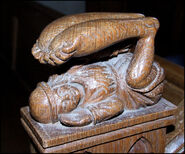Этимология названия[]
Название «сциоподы» происходит от греческого σκιαποδες — «ноги-тени» (так как в легендах о сциоподах говорится, что они могли во время отдыха укрывать своей огромной ступнёй своё туловище от солнечных лучей), слово «монокули» — от греческого μονοκωλοι, что означает «одноноги».
Мифология[]
Сциоподы (также известные как моноподы, монокули) — мифологические карликовые существа, имеющие одну огромную ступню, которой заканчивается единственная же тонкая нога, идущая от центра их туловища.
В Древней Греции и Риме[]
Monopods appear in Aristophanes' play The Birds, first performed in 414 BC. They are described by Pliny the Elder in his Natural History, where he reports travelers' stories from encounters or sightings of Monopods in India. Pliny remarks that they are first mentioned by Ctesias in his book Indika (India), a record of the view of Persians of India which only remains in fragments. Pliny describes Monopods like this: "He [Ctesias] speaks also of another race of men, who are known as Monocoli, who have only one leg, but are able to leap with surprising agility. The same people are also called Sciapodae, because they are in the habit of lying on their backs, during the time of the extreme heat, and protect themselves from the sun by the shade of their feet."
Philostratus mentions Skiapodes in his Life of Apollonius of Tyana, which was cited by Eusebius in his Treatise Against Hierocles. Apollonius of Tyana believes the Skiapodes live in India and Ethiopia, and asks the Indian sage Iarkhas about their existence.
St. Augustine (354–430) mentions the "Skiopodes" in The City of God, Book 16, chapter 8 entitled, "Whether Certain Monstrous Races of Men Are Derived From the Stock of Adam or Noah's Sons."
В средние века[]
Reference to the legend continued into the Middle Ages, for example with Isidore of Seville in his Etymologiae, where he writes: "The race of Sciopodes are said to live in Ethiopia; they have only one leg, and are wonderfully speedy. The Greeks call them σκιαπόδεϛ ("shade-footed ones") because when it is hot they lie on their backs on the ground and are shaded by the great size of their feet."
The Hereford Mappa Mundi, drawn c. 1300, shows a sciapod on one side of the world, as does a world map drawn by Beatus of Liébana.
Происхождение[]
According to Carl A.P. Ruck, the Monopods's cited existence in India refers to the Vedic Aja Ekapad ("Not-born Single-foot"), an epithet for Soma. Since Soma is a botanical deity the single foot would represent the stem of an entheogenic plant or fungus.
Объяснение[]
John of Marignolli (1338–53) provides an explanation of these creature. Quote from his travels from India:
- «The truth is that no such people do exist as nations, though there may be an individual monster here and there. Nor is there any people at all such as has been invented, who have but one foot which they use to shade themselves withal. But as all the Indians commonly go naked, they are in the habit of carrying a thing like a little tent-roof on a cane handle, which they open out at will as a protection against sun or rain. This they call a chatyr; I brought one to Florence with me. And this it is which the poets have converted into a foot.»
- — Giovanni de' Marignolli
В популярной культуре[]
- Присутствуют в цикле книг «Хроники Нарнии» Клайва Стейплса Льюиса.
- Умберто Эко в своем романе "Баудолино" описывает сциапода именем Гавагаи.




